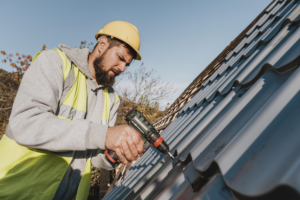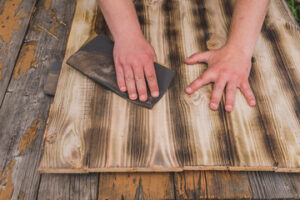Charleston Siding Repair is a significant investment, but there are ways to lower the cost. The first is to determine if the damage is easily repairable. For small cracks and holes, simply measure the broken section of siding and cut a replacement board to size.
Homeowners should address any issues as soon as they notice them to avoid costly damage down the road. Leaving small problems unattended can snowball into bigger issues, like rotting or mold.

Aside from reducing curb appeal, cracks and holes in vinyl siding allow water to penetrate the wall, causing extensive damage over time. If left untreated, water can cause the wall to rot, mold to develop, and weaken the foundation of your home. Fortunately, these issues can be prevented with a few simple steps.
Before beginning your repair, locate the crack or hole and determine how big it is. This will help you decide which method to use for the repair. For small divots and holes less than an inch in diameter, you can simply apply caulk to the area. This will seal the blemish and prevent water from infiltrating your walls.
Larger holes may require a patch, which can be found at many home improvement and hardware stores. To prepare the patch, cut away a 2 in (5.1 cm) perimeter around the damage. This will help you make straight and even guidelines that will ensure your new replacement piece fits correctly.
Once the patch has been prepared, it is important to clean the surrounding area to ensure optimal adhesion of the caulk. This will also ensure that the crack or hole is free of any dirt or debris that could negatively impact the appearance of your home’s exterior.
When repairing a crack or hole in vinyl siding, you will want to use an exterior caulk that is color-matched to your existing wall to ensure that the repair is undetectable. When applying the caulk, be sure to use a wide enough bead to effectively cover the damaged area. Once the caulk has been applied, wait for it to dry before attempting to touch up any paint that may be affected.
While this repair can be completed by a competent DIYer, if you are not comfortable working with tools like tin snips or utility knives, it is a good idea to call in a professional to ensure the job is done correctly and safely. Additionally, if you are noticing extensive damage to your vinyl siding, it is often more cost-effective and efficient to hire a professional.
Warping
If you have noticed that your home’s siding has begun to droop, buckle, or twist, you may be dealing with what is known as warped siding. Not only does this problem look unsightly, but it can also cause serious moisture problems and damage to your home’s inner walls. This problem can be caused by a number of different factors, including excessive heat, improper installation, and dark paint colors.
Excessive heat exposure is the most common reason for vinyl siding to warp. This usually happens during the summer when sunlight is directing a lot of thermal energy toward your house’s exterior. Since vinyl is a type of plastic, it will begin to melt as the thermal energy causes it to expand. This is especially problematic for older vinyl siding, as well as dark-colored vinyl.
Other reasons for warped siding include the use of poor quality vinyl or an unreliable brand, and poor installation. If your vinyl is nailed down too tightly, it will not have enough room to expand during hot weather and will warp or buckle as a result. This is especially a concern if your vinyl was installed without the proper ventilation, as the lack of airflow can lead to moisture problems.
It is important to check your siding regularly for signs of warping and other damage, including cracks and holes. You can do this by conducting a visual inspection and by running your hands over the surface to feel for weak spots. It is also a good idea to conduct regular inspections after severe weather, as strong winds or hail can lead to cracks in your siding.
Moisture infiltration is another common problem that can contribute to warping and other types of damage to your home’s exterior. Water seeping through gaps, cracks, or poorly sealed joints can damage the inner walls and lead to mold growth. You can prevent moisture from infiltrating your home by caulking joints, replacing damaged siding, and ensuring that there are adequate vents in your roof’s soffit or behind your siding.
Peeling Paint
Paint can crack and peel when the surface beneath it is damaged or if moisture seeps through gaps in the siding. If the problem is limited to a small area, you can usually repair it by applying a caulking solution made for exterior use.
If you have more extensive areas of peeling paint or if the siding itself is damaged, it may be best to hire a professional. A qualified painter can remove all of the old paint, thoroughly clean and prep the surface for painting, repair any damage, and apply a fresh coat of high-quality exterior grade paint that resists moisture.
A thorough cleaning and prep process is essential to prevent future problems with your vinyl siding. The cleaner your surface is, the better it will adhere to primer and paint. It is also important to remove any moss, mildew or dirt from the surface. A good power wash followed by a thorough rinse will ensure that your surface is free of debris and contaminants.
Moisture can cause wood to expand and shrink. This can lead to blistering, peeling, and flaking. A thorough inspection can help you determine the source of moisture and address it to avoid future problems with your siding.
In many cases, a peeling paint job is caused by poor surface preparation or moisture seeping in through gaps in the vinyl siding. Jane had peeling paint on her home that was a clear indication of the need for a siding replacement. She contacted our team and they identified the root cause of the issue. The team removed the peeling paint, cleaned and prepped the surface for painting, repaired any cracks or holes in the siding, sanded the surface smooth, and applied a new coat of high-quality exterior grade paint that was moisture resistant.
The results were stunning. The new paint job added significant curb appeal and provided a much-needed layer of protection against the elements. Jane also established a routine of regular cleaning and maintenance that will help her to prevent future issues with her vinyl siding.
Water Damage
When wood siding gets wet, it often starts to rot. This can leave holes, create loose areas, or lead to more serious structural problems within your home. It’s essential to catch this problem early by keeping a close eye on your siding and recognizing the warning signs. Regular inspections, especially after storms and during humid seasons, can help prevent water damage from causing costly issues down the road.
In addition to obvious holes and cracks, you can also notice the presence of fungus or algae, discoloration, or streaks on your home’s exterior. These organisms thrive in moist environments and are a clear indication that your siding needs repair or replacement.
Another surefire warning sign is a musty smell near walls, which can indicate a hidden mold issue. You may also notice a higher than normal number of pests, as they are attracted to rotting and damp wood.
Depending on the severity of the damage, you may need to remove the affected boards before proceeding with your repair. Start by carefully lifting the nails with a pry bar, taking care not to damage the underlying structure. Once the boards are removed, you can replace the damaged sheathing and install a waterproof barrier such as house wrap to protect against future moisture infiltration.
For divots and holes less than an inch in size, you can usually repair them with caulking material that matches your existing siding. Simply load a caulking gun with your preferred filler and apply it to the divot or hole, slightly overfilling it to account for shrinkage as it dries. Once the caulking is dry, sand it smooth with medium-grit sandpaper and then prime and paint as directed by the product’s instructions.
For larger holes, sagging areas, or missing portions of your siding, it’s time to call in a professional contractor. A trusted and experienced provider can evaluate your siding’s condition, determine the source of the problem, and provide a full range of repairs to ensure that your home’s protective exterior is in good working order for years to come. Whether you have vinyl, wood, or masonry siding, prevention is key to avoiding costly water damage. Regular inspections and proactive measures like cleaning gutters, directing downspouts away from your foundation, and maintaining a high-quality protective coating can significantly reduce the risk of moisture infiltration and structural damage.


